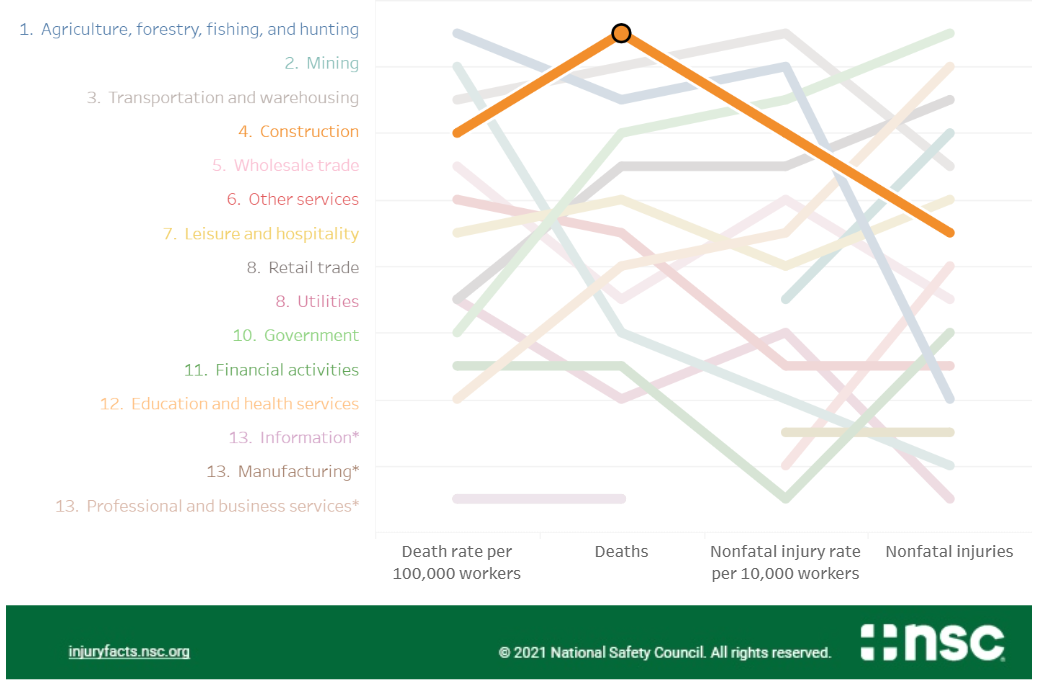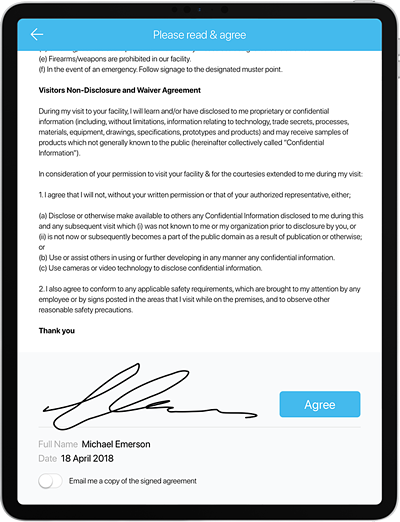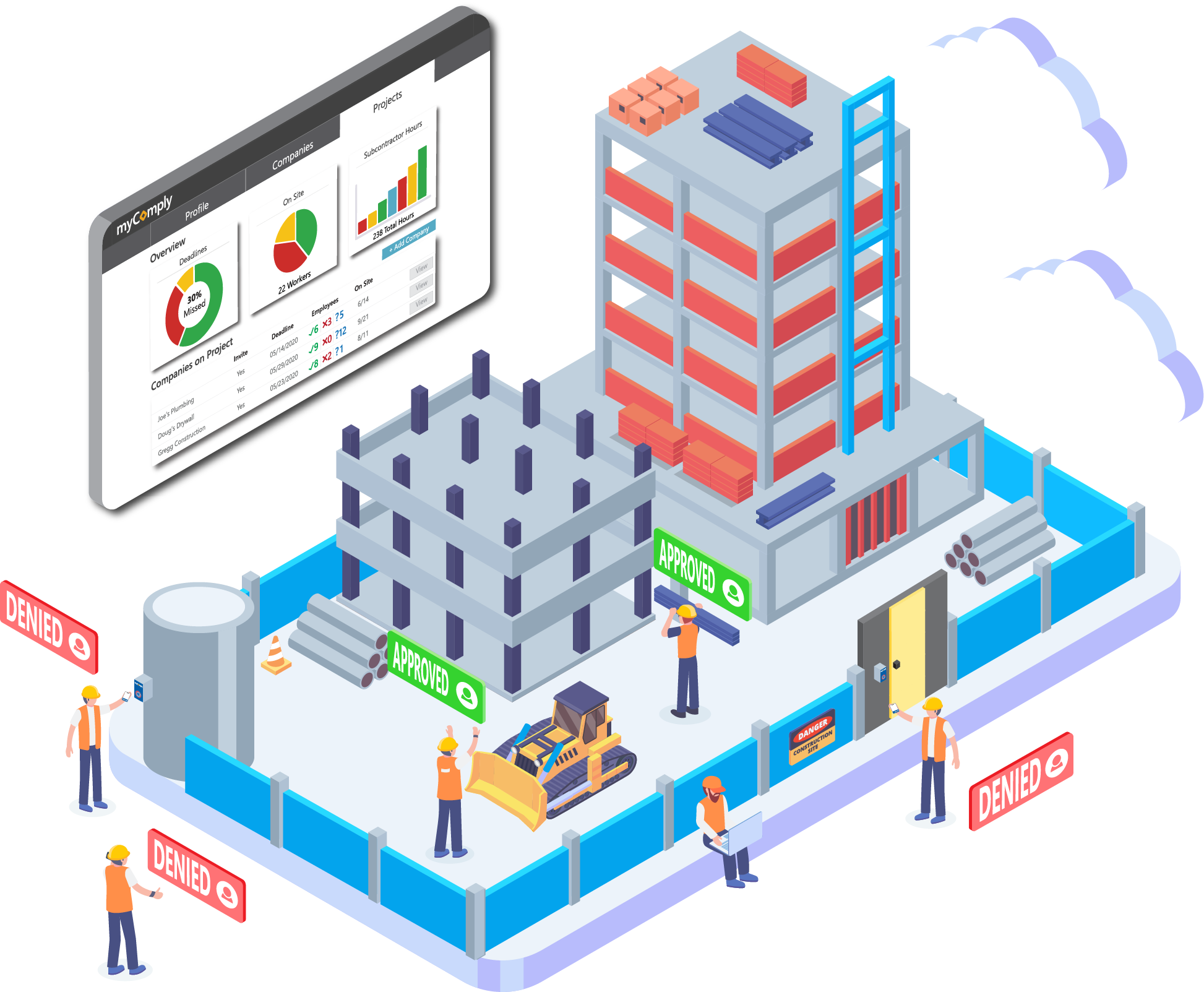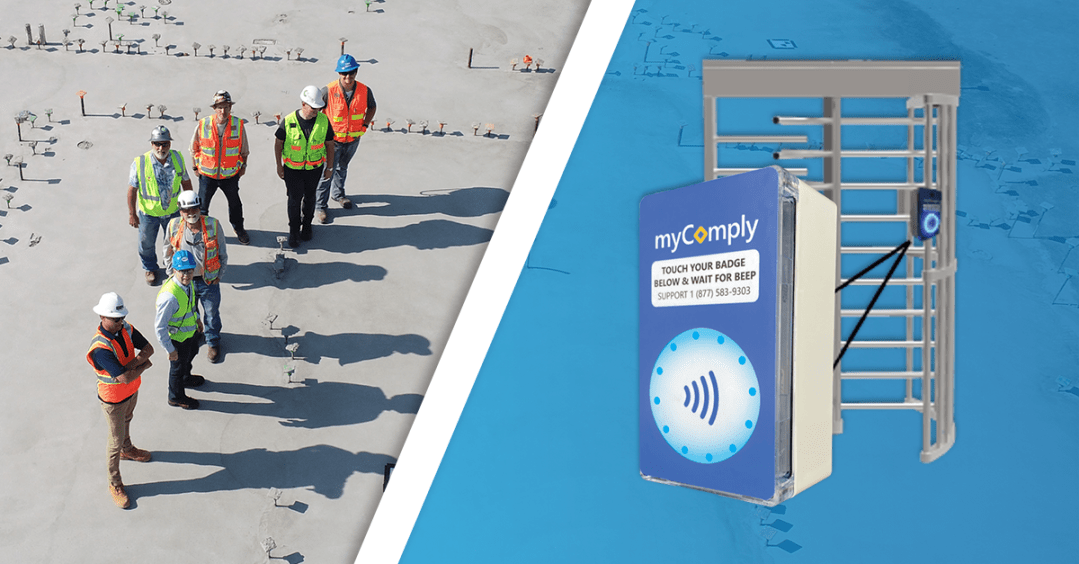By temporary access solutions, we don’t mean access roads. This article is all about managing visitor access on construction sites and why you might need to rethink your visitor induction and access control process.
Read on to learn why it’s critical that you monitor all site access in order to improve safety, how to deter unwanted visitors, how to induct site visitors, and how to implement an effective temorary access control solution for you construction site.
Table of Contents
Why Monitoring Temporary Access for Construction Sites is Important
Maintaining Site Safety
Deterring Unwanted Foot-Traffic
Standard Construction Site Induction vs Site Inductions for Visitors
Construction Site Inductions
Construction Site Inductions for Visitors
The Challenge: Regulating Access Control
3 Ways to Regulate Temporary Construction Site Access
1. Visitor Management Systems
2. On-Site Security
3. Access Control Systems
myComply for Access Control
Why Monitoring Temporary Access for Construction Sites is Important
At first glance, managing temporary access to a construction site might seem like a trivial topic. However, when we consider the dangerous nature of these work environments and the ease at which unwanted/unregulated visitor traffic can sometimes gain access to a project site, the value in temporary access solutions for construction sites becomes obvious.
Here are some of the numbers.
Maintaining Site Safety
Construction sites are among the most dangerous work environments in the world, leading in total fatalities and ranking fourth across all major industries. In fact, among the top 20 most dangerous jobs in America in 2018, five of them belong to the construction sector.

Here are the specific rankings and fatality rates:
- Roofers
- 41 fatal injuries per 100,000 workers
- Ironworkers
- 29 fatal injuries per 100,000 workers
- Crane operators
- 19 fatal injuries per 100,000 workers
- Construction helpers
- 18 fatal injuries per 100,000 workers
- Cement masons
- 17 fatal injuries per 100,000 workers
And these stats pertain to individuals that are trained to be working in these environments. When you have potentially untrained or inexperienced individuals entering a dangerous environment, the threat to their safety becomes much greater.
Deterring Unwanted Foot-Traffic
In a lot of ways, construction sites are kind of like unsecured bank vaults, with tens of thousands of dollars of materials and equipment often left-out and exposed. Due to the high value of much of this equipment, it is often targeted by thieves.
In fact, it is estimated that losses resulting from theft on construction sites are greater than $1 billion per year in the United States. Additionally, the average loss on a construction site is valued at $30,000, and there were more than 11,000 of these incidents (that were recorded/reported) in 2016.
Without the proper security and access control measures in-place, it can be rather easy for pedestrians to gain access to construction sites where they might have criminal intent. But, before we dive into that, let’s discuss the differences between a standard site induction/orientation and one that visitors might receive.
Standard Construction Site vs Site Inductions for Visitors
Workers and employees need proper site inductions before they enter a project site, that much is certain. However, what about architects, surveyors, office staff, project owners, or other stakeholders that may need to garner temporary access to a project site?
Let’s explore the operational differences between standard site inductions and construction site inductions for visitors.
Construction Site Inductions
Construction site inductions, otherwise known as orientations, are a very necessary part of the project training process. These inductions serve to provide workers with all the information that they need regarding site layouts, job-specific risks, as well as general hazards, so that they can conduct safe work on the site.
Construction Site Inductions for Visitors
Construction site inductions for visitors are a little different. These also serve to educate individuals that will be entering potentially dangerous construction sites, but generally need to be done in a much quicker fashion.
Though there is no regulation governing the entrance of site visitors, there is the employers “general duty” clause of the Occupational Safety and Health Administration (OSHA) Act.
Under this clause:
“Each employer (1) shall furnish to each of his employees’ employment and a place of employment which are free from recognized hazards that are causing or are likely to cause death or serious physical harm to his employees; (2) shall comply with occupational safety and health standards promulgated under this Act.”
Though this is somewhat ambiguous, it does make it very clear that employers are responsible for managing hazards within their workplace. Construction sites are riddled with hazards, and GCs are liable for any harm to come to anyone who is granted access to their sites. Based on that logic, it stands to reason that a responsible GC would want to offer a short site induction or project briefing before issuing temporary site access.
Access the complete OSHA Act here.
The result is that visitor inductions tend to be much briefer than those provided to workers, and they tend to be accompanied by more legal documentation (waivers, NDAs, etc) to protect the GC/CM and project owner.
The Challenge: Regulating Access Control
So, we’ve established two things:
- The ability to grant approved temporary access to construction sites is essential
- Temporary site visitors should have some form of site induction or briefing
HOWEVER, when construction sites need to effectively grant access to certain individuals, it can be difficult to document, track, and report on the flow of these persons.
At best? Visitors navigate to a mobile office trailer where a Project Manager or Superintendent provides a quick briefing and issues some form of visitor badge.
At worst? Individuals waltz onto a project site without any regulated access and navigate to their destination. No documentation. No project briefing.
3 Ways to Regulate Temporary Construction Site Access
Fortunately, there are other options available to GCs and CMs that want to better regulate and document visitors who are granted temporary construction site access.
1. Visitor Management Systems
Visitor management systems are dedicated hardware and software solutions that enable businesses, schools, and other entities to track the flow of visitors in a digital format and (sometimes) print visitor badges or cards.

Source: Swipedon
The benefits to visitor management systems for temporary access control:
- Document digitization. In order to grant visitors access to a construction site, they are often required to complete some level of site induction and sign certain NDAs and/or safety waivers in order to protect the GC/CM and owner of the project. Visitor management systems help to digitize this documentation and can accelerate the check-in process.
- Brief visitors on safety precautions. Rather than conducting an in-person induction, some visitor management systems allow you to bundle up all your waivers and safety information into one digital package.
- Emergency evacuations. So long as visitors have notified the proper site authorities of their entrance and exit of the project site, they can easily be tracked and accounted for in the event of an emergency evacuation.
The downside to visitor management systems is that they do little to enforce or ensure that visitors have completed their NDAs/safety waivers/orientations before they enter a project site. This screening process is left in the hands of the visitors as well as PMs, Superintendents, or on-site security personnel that govern the site.
2. On-Site Security
On-site security personnel can also be an effective means of monitor visitor traffic. This is a more manual solution, but security personnel can act as the access control mechanism by being positioned and key access points. They determine which workers are approved to enter the site and can direct visitor traffic to PMs and site Superintendents.
The benefits to on-site security for temporary access control:
- Visitor experience. Having a warmer, more personal touch can improve the visitor experience, which can be very valuable if the visitor happens to be a project owner or other key stakeholder.
- Deterrence. Having a human presence monitoring the access points on your construction site can go a long way with respect to deterring and preventing criminal or negligent behavior.
The downside to on-site security staff is the cost associated with having full time personnel working at each access point. There is also human error to consider, as it is more likely that an unqualified worker or visitor might be granted site access by a human than by an access control system.
3. Access Control Systems
Access control systems are hardware and software bundles that integrate with your existing site access points, be those turnstiles, door strikes, or otherwise. Smart hardware connects with these access points and allows GCs/CMs to limit site access to only those that are approved. On the software side, data is collected and can easily be monitored and leveraged by GCs or project owners.

The benefits to access control systems for regulating visitors:
- No unapproved access. Unlike other solutions which might allow visitors to slip through the cracks without having completed the necessary paperwork/site induction, access control systems force all visitors to consult with a PM in order to get a badge/decal printed that will then grant them access to a project site.
- Custom expiration dates. Access control systems require badges or NFC-enabled devices to grant site access. For visitors, these badges can be set to expire after one day so that all visitors have to check-in prior to entering a jobsite.
- Worker profiles. Access control systems allow GCs to monitor all worker/subtrade traffic in real-time. The same is true for visitors. Whether you’re on-site or in a corporate office, you will know exactly who is on your project and when.
- Digital site inductions. Some access control solutions also come with an online orientation component which enables GCs/CMs to send out relevant site documentation or training materials prior to a visitor ever coming near a project site.
Learn More: Construction Access Control: The Gateway to Greater Projects
myComply for Access Control
myComply is the leading access control system for project owners, GCs, and CMs in North America. If you are looking to take the reins on your project sites and unlock deep data on your workforce, then myComply is the answer you have been searching for.
Here’s what makes myComply’s Construction Site Access Control system special:
- Hardware meets software. Physical access points, such as turnstiles and door strikes, are integrated with myComply Smart Bricks, which are then connected to the Projects Pro Through the scanning of a Smart Badge, and with lightning-fast LTE connectivity, these bricks reference your project database and determine whether a worker is qualified and authorized to be on your job site.
- Grant temporary access with ease. So long as you have a Project Manager or Site Superintendent that can run myComply’s card issuer, temporary Smart Badges can be issued to all approved visitors and site access can be granted.
- Verify time and attendance. myComply’s access control solution uses every badge scan as a start point or end point on worker hours. This allows GCs to verify employee, subtrade, and worker hours, eliminating the risk of labor inflation.
- Access real-time data. Everything on the myComply platform is live. That means that your Projects Pro dashboard is always displaying live site information, without so much as a seconds delay. This allows project visibility, anywhere, anytime.
- Unlock automated reporting. Require reports for various stakeholders? Not a problem. Project compliance reports, worker certifications summaries, demographic details. Timesheets, and more can all be automatically generated from the myComply platform.



